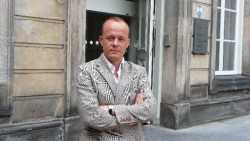
Ilsink 2003
“Van Eyck, Van der Weyden, Van der Goes, Van Aken. Twee studies over vroege Nederlandse tekenkunst en een geveilde tekening” (Matthijs Ilsink) 2003
[in: Millennium, vol. 17 (2003), nr. 1, pp. 49-57]
As a result of the Bosch exhibition in Rotterdam (2001) quite a number of new books about Hieronymus Bosch have been published. Highlight of the Bosch mania was the sale of a drawing from Bosch’s circle in New York on 21st January 2003 (Ilsink publishes an illustration of the drawing). This sheet, completely unknown until recently, shows a hell scene and was sold for $ 276,800. In the auction’s catalogue Fritz Koreny dates the drawing around 1505-1515 and attributes it to an unknown hand from Bosch’s ‘immediate circle’.
Ilsink then reviews two publications about Early Netherlandish drawings in which the drawings by Bosch and his circle are discussed. First Stephanie Buck’s substantial catalogue of fifteenth-century Netherlandish drawings in the Berlin Kupferstichkabinett: Die Niederländischen Zeichnungen des 15. Jahrhunderts im Berliner Kupferstichkabinett. Kritischer Katalog (Berlin-Turnhout, 2001). Ilsink praises Buck’s detailed analysis of the drawings but does not always agree with her. For example: he does not believe that the drawing with Two Phantastic Creatures (cat. I.32) is an authentic Bosch drawing.
In Early Netherlandish Drawings from Jan van Eyck to Hieronymus Bosch (Antwerp, 2002), a book published on the occasion of the exhibition with the same name in the Antwerp Rubenshuis in 2002, the Viennese art historian Fritz Koreny (in cooperation with Georg Zeman and Erwin Pokorny) offers a broad panoramic view on the evolution of Early Netherlandish drawing. The drawings are divided in four groups, centering around Jan van Eyck, Rogier van der Weyden, Hugo van der Goes and Hieronymus Bosch. In the section which is allotted to Bosch Koreny turns the complete oeuvre of the master upside down: next to Bosch’s own hand he discerns the hands of four workshop assistents. Among them the left-handed so-called ‘Master of the Haywain Triptych’, who – according to Koreny – was also the painter of the Prado Haywain ànd of the Lisbon St. Anthony triptych, the Rotterdam Pedlar, the Washington Death of a Miser and the Paris Ship of Fools. Ilsink thinks that more research is needed before Koreny’s assertions can be confirmed. It is also noteworthy that Koreny adds two drawings with birds and mammals (Berlin) to Bosch’s authentic oeuvre.
Ilsink’s article contains a nice sentence worth of being remembered: ‘In science the increase of hypotheses is always inversely proportional to the number of available data’ [p. 54].
[explicit 1st November 2012]